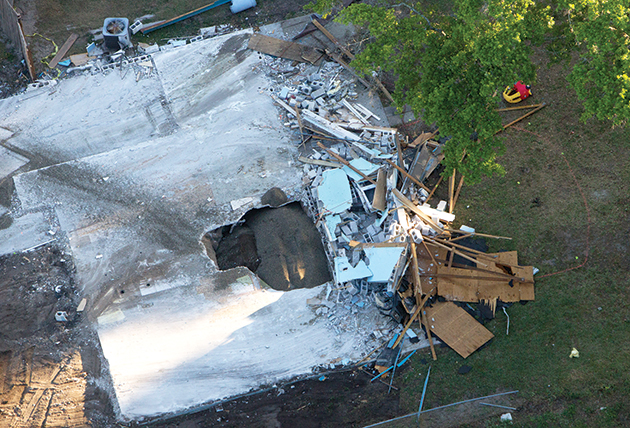An aerial view shows a sinkhole at the home of Jeff Bush in Seffner, Florida. Bush was killed when the sinkhole opened up under his bedroom in March.
It sounded almost apocalyptic. On February 28 in Florida, the earth suddenly opened, and a gaping sinkhole swallowed Jeff Bush and part of his home. His body will never be recovered. Fortunately, tragedy of this scale is rare, although sinkholes themselves are not, especially in Florida, where they occur most often.
Sinkholes form when near-surface caves collapse. Rain and groundwater percolate along cracks in limestone, dolomite and similar rocks, slowly dissolving calcium and other minerals, eventually creating open spaces. As these spaces expand, they may become so unstable that they cannot support the weight of the overlying surface and collapse on themselves, creating depressions (sinkholes) at the surface. Subsidence can be gradual or, in the case of Jeff Bush, sudden.
Changes in water-table levels often trigger the development of sinkholes. During dry conditions, the water table drops, drawing water away from the subsurface caves, creating more instability. Prolonged rainfall can dissolve more limestone underground and make the overlying soils heavier, also increasing the risk of sinkholes.
Sinkholes are the surface expressions that identify karst topography—geographic areas underlain by limestone that are dotted with circular collapse structures, where the surface has fallen into collapsed, near-surface caves. More than half of Florida is classified as karst terrain. Overall, about 25% of the United States is underlain by such terrain, meaning these areas are susceptible to sinkholes to varying degrees.
With more than 15,000 sinkholes verified in their state, Florida homeowners are particularly knowledgeable about the risks, especially in “sinkhole alley” in Hernando, Pasco, Hillsborough and Pinellas counties. But even with careful due diligence, sinkholes are difficult to predict. Five months before the depression appeared under Bush’s house, for example, the property had been inspected by an insurance company that declared it free of sinkhole risk. Inspectors took the standard approach and looked for property damage that could be related to sinkhole development, such as landscape changes, cracked walls and foundations, or ill-fitting doors. (Most owners and insurance companies don’t carry out sub-surface testing because it is very expensive and sometimes inconclusive.)
Most Americans don’t fully understand their insurance policies when it comes to sinkhole coverage. This includes Floridians, but it is especially the case in states where sinkhole activity is less of a threat. For example, many homeowners mistakenly believe their standard policies cover sinkhole damage. And even if they did want extra sinkhole coverage, chances are many would decline it because of the cost.
A rapid increase in sinkhole claims from 2006 to 2010 (many of which were fraudulent in nature, according to insurers) compelled the Florida legislature to pass a law in 2011 that actually makes it harder for Floridians to obtain sinkhole coverage. Insurers must provide “catastrophic ground cover collapse,” which may or may not cover sinkholes, depending on the circumstances. Optional coverage for sinkholes can be purchased but is pricey; with annual premiums as high as $1,000 or more, many homeowners have decided to forego coverage and take their chances.
With more extreme weather expected from global warming and continued property development in karst areas (often without proper testing for sinkhole risk), chances are good that more and possibly larger sinkholes will develop in the future. Deeper draw-down from municipal and high-capacity wells, as communities and industries expand, only helps to fuel the threat.
Despite these risks, Florida has not made any moves to strengthen building codes or require sinkhole testing before new homes or commercial buildings are built. And even when developers do conduct pre-construction testing, they typically rely on the standard engineering approach of drilling several boreholes to test the subsurface, a practice that can easily miss sinkholes.
“What they fail to realize is that sinkholes are a geologic process,” said Anthony Randazzo, co-principal with Geohazards Inc., a geotechnical consulting firm in Gainesville, Florida. “Unfortunately, most engineers do not utilize geologic testing methodologies.”
Geohazards uses geophysical techniques such as ground-penetrating radar and electrical resistivity to identify anomalies in the subsurface that are likely to be sinkholes. These targets can then be tested by drilling; if sinkholes are encountered they can usually be remediated by filling them with grout.
Randazzo says his methods are 90% accurate in identifying sinkholes. Drilling only a few holes, or even grid drilling, can miss anomalies altogether, particularly small anomalies that may be related to larger karst structures or expand in size quickly on their own.
What’s more, this peace of mind is relatively inexpensive to obtain. Geological testing for sinkholes for a 10,000-square-foot project costs approximately $3,000, a drop in the bucket compared to the overall construction budget of a home, let alone a commercial facility.
“We’re trying to get the engineering community to embrace testing construction sites with geophysical methods first,” said Randazzo. “It is a quick and effective way to identify sinkhole risks that can then be followed up and confirmed with engineering methods. If conditions of sinkhole activity are identified, they can typically be remediated before construction starts, eliminating what could have been a source for serious building damage or collapse in the future.”

